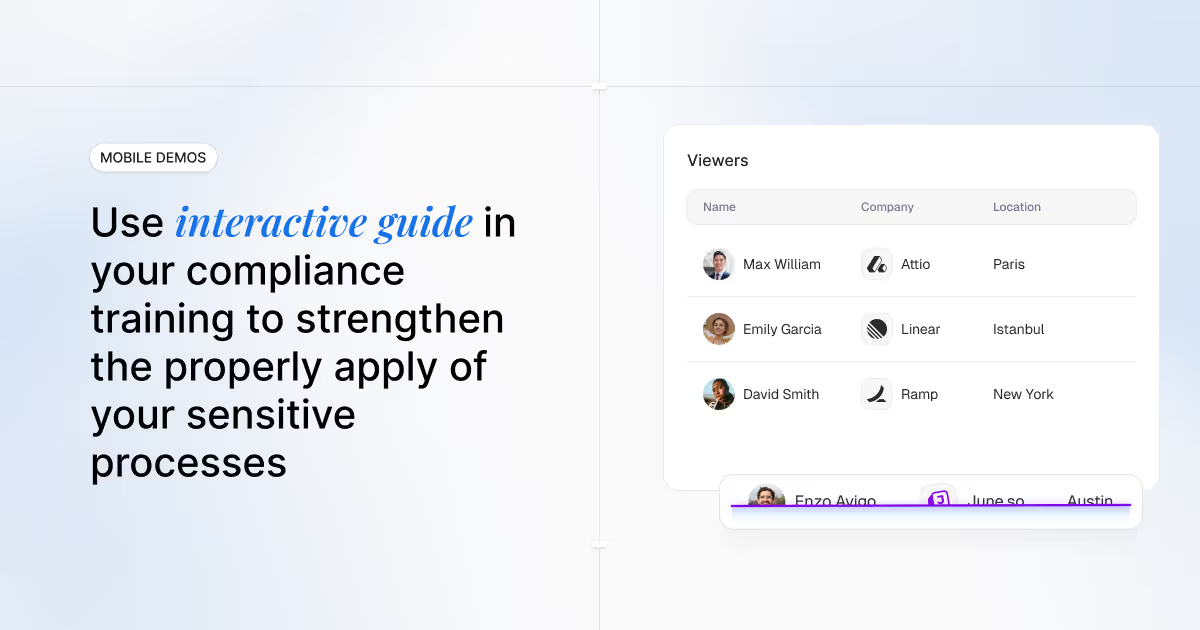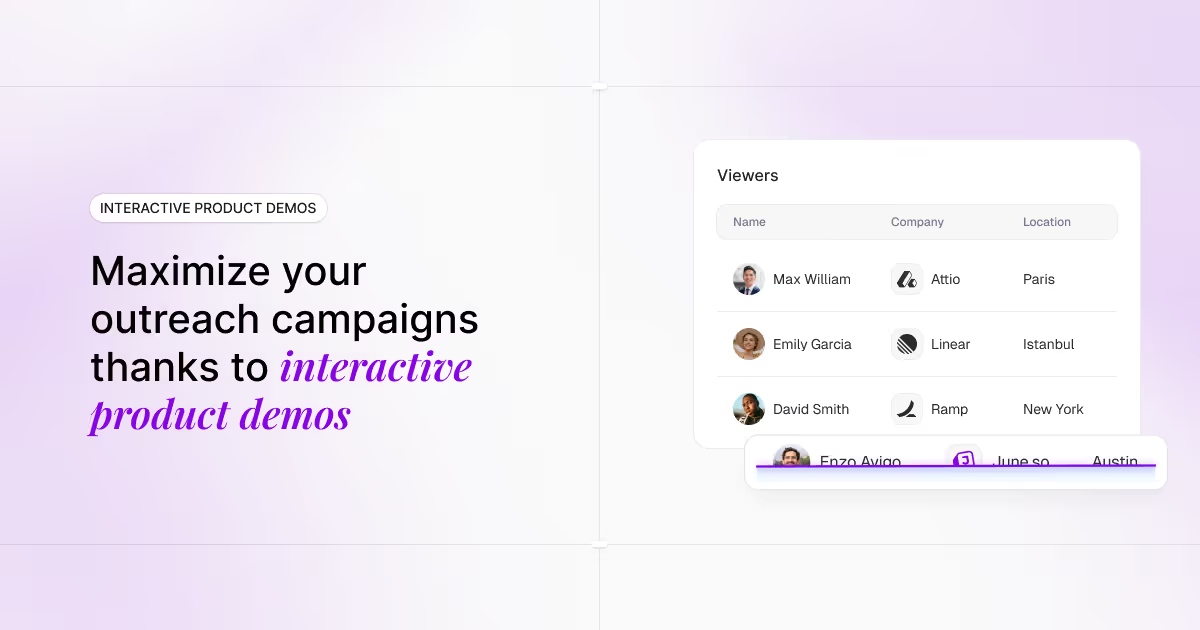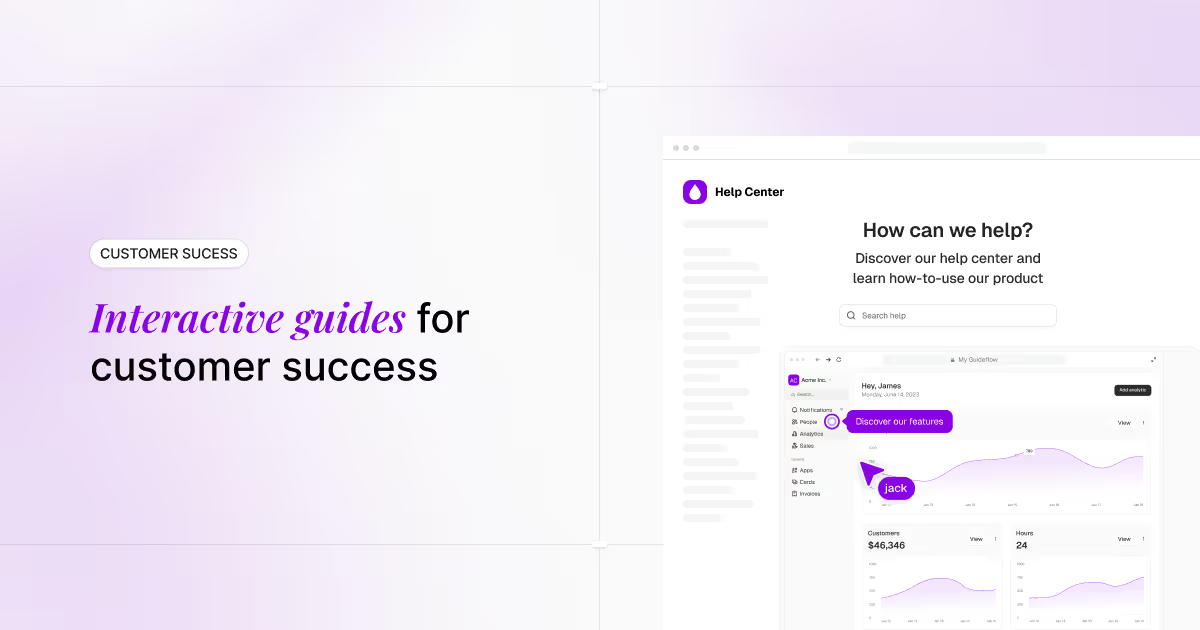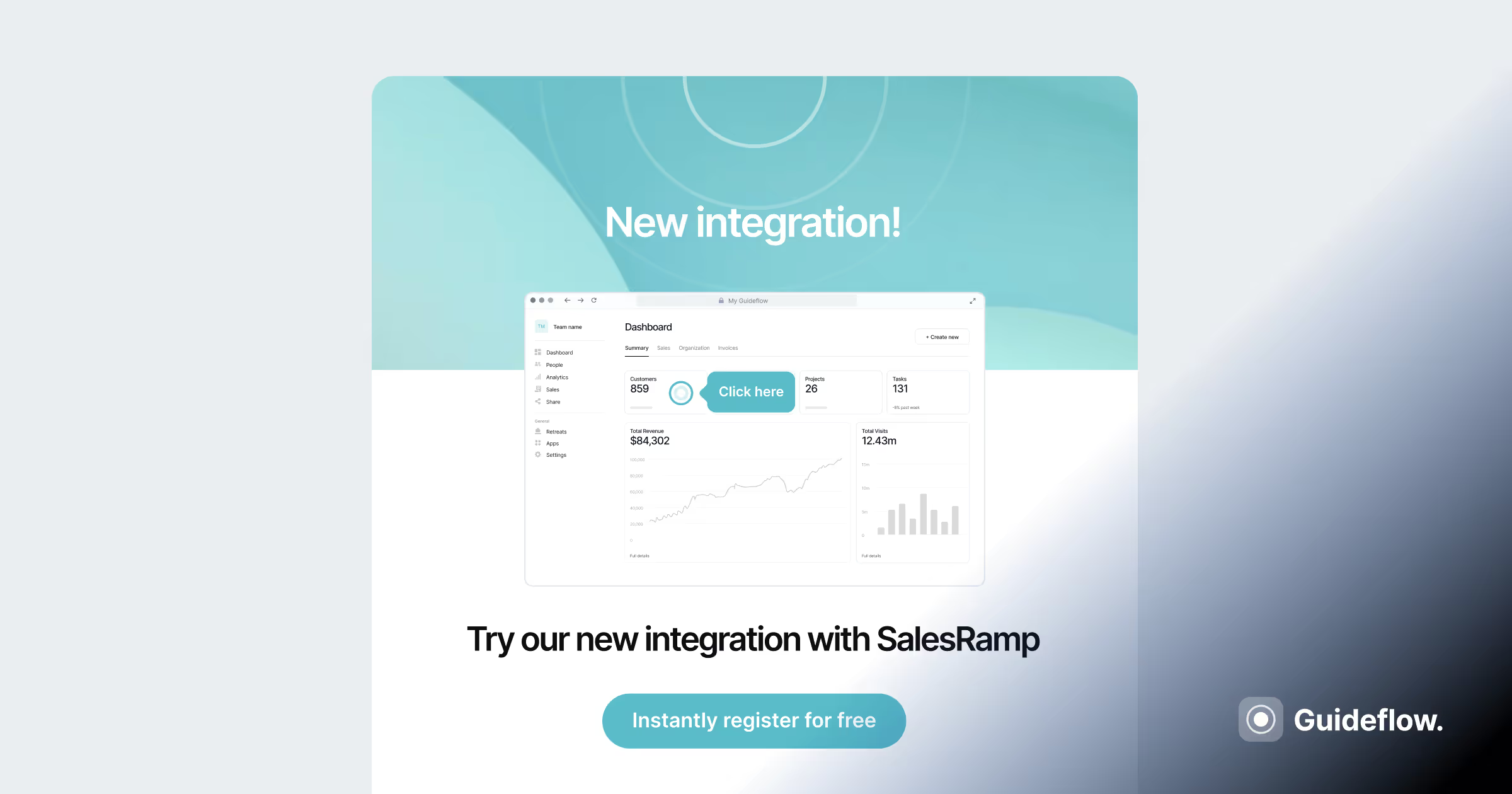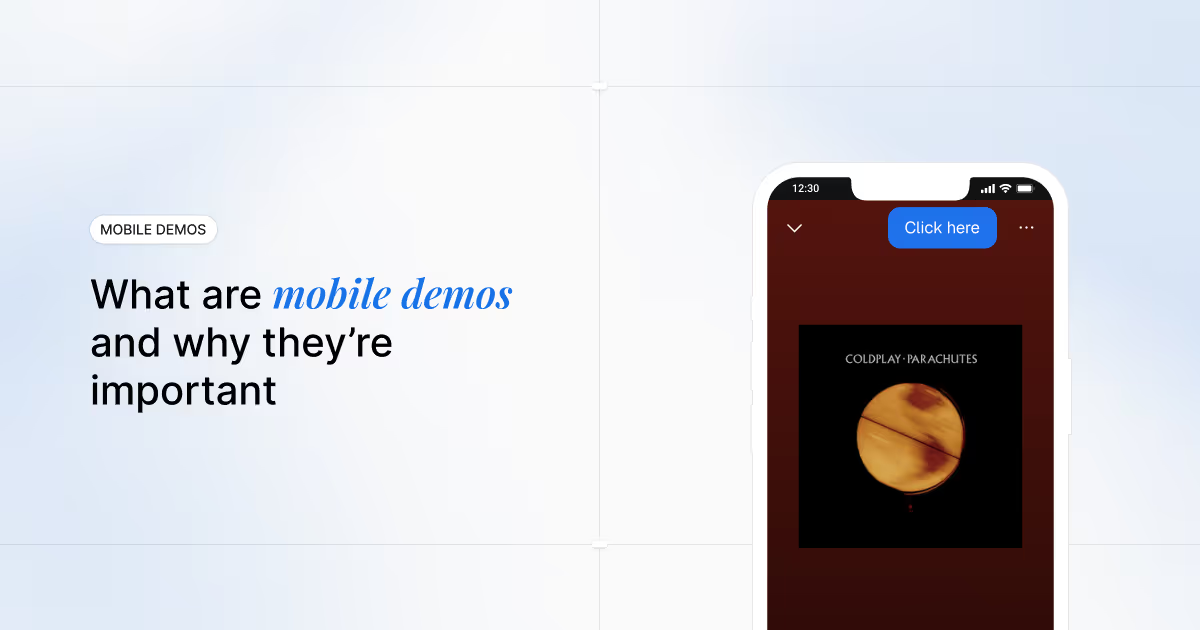What are interactive demos and why are they important for partnership managers
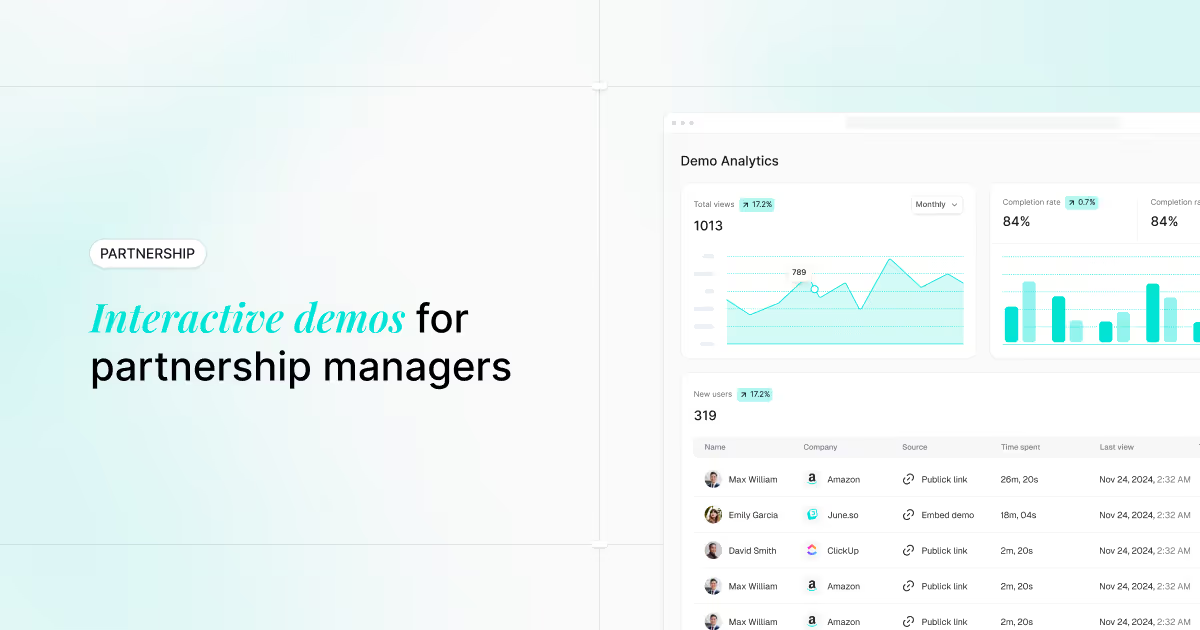


Partnership managers sit at the crossroads of strategic growth, building alliances, co-marketing initiatives, and integrated product solutions that drive mutual value. Their role spans identifying and negotiating partnership opportunities, onboarding and enabling external teams, and ensuring long-term success through performance tracking, optimization, and compliance. But enabling partners at scale is challenging. Too often, teams rely on repetitive meetings, static PDFs, or inconsistent messaging, resulting in low engagement and missed opportunities.
Today, the most successful partnership teams are turning to interactive demos to deliver scalable, on-brand, and impactful partner experiences, without increasing headcount or meeting fatigue.
Try it now: Create your first product launch demo with Guideflow
TL;DR: Why this guide matters
This guide demonstrates how partnership managers deploy interactive demos to address five critical challenges. First, they streamline co-sell by replacing repetitive training sessions with on-demand product walkthroughs that sales teams access instantly. Second, they transform partner onboarding from document-heavy processes into hands-on exploration that cuts ramp time significantly. Third, they showcase integrations through concrete scenarios that make technical capabilities immediately clear to non-technical audiences. Fourth, they fuel joint go-to-market initiatives by giving internal teams shareable assets that demonstrate genuine product value rather than abstract claims. Fifth, they surface actionable engagement metrics that reveal which partners are active and where knowledge gaps require attention.
Interactive demos eliminate training bottlenecks, accelerate partner productivity, and enable self-serve education across your ecosystem. What follows: specific use cases, techniques for building high-impact demos, and templates ready for immediate deployment.
The challenge of partnership management
Partnership teams are critical to revenue growth and ecosystem strategy, but they face constant friction. Repetitive onboarding of new partner reps drains resources, while inconsistent messaging about your product and integrations weakens the partner value proposition. Low partner engagement in co-marketing or co-selling limits revenue potential, and the lack of scalable training tools makes it difficult to enable partners effectively. Interactive demos solve this by letting partners learn, share, and sell without friction or delays.
What are interactive demos for partnership managers?
Interactive demos are guided, clickable walkthroughs of your product or integration workflows that partners can share in calls, embed in campaigns, or explore independently. They solve a fundamental problem: partners need to understand how your solution works, why it matters, and how to position it - without requiring repeated training sessions or lengthy documentation.
These demos transform partner enablement by training partner reps on how your product fits into joint solutions, showcasing integrations in co-marketing campaigns with tangible proof points, arming partners with shareable assets that demonstrate real product value, and creating consistency across every partner touchpoint. Unlike static slides or PDFs, interactive demos don't just explain features - they reveal business impact and equip partners to sell confidently.
Why interactive demos transform partnership management
1. Streamline partner enablement at scale
Partnership managers face the challenge of onboarding and training dozens or hundreds of partners, each requiring product knowledge to effectively promote and sell the solution. Without interactive demos, this means countless repetitive calls, presentations, and walkthroughs that drain resources and slow down activation. Interactive demos solve this by allowing partners to self-educate through guided, hands-on experiences. Partners can explore features, understand use cases, and learn at their own pace, transforming enablement from a time-intensive process into a scalable system that works around the clock.
2. Improve co-sell readiness and partner confidence
Many partnerships fail to generate pipeline because partner sellers lack the product knowledge and demo assets needed to effectively present the solution. They struggle to articulate value, answer technical questions, or showcase integrations during customer conversations. Interactive demos equip partner sales teams with self-service product experiences they can share directly with prospects. This reduces dependency on internal solution engineers, accelerates deal cycles, and increases partner confidence. When partners can demonstrate the product themselves, they become true extensions of your sales team.
3. Launch integrations with clarity and adoption
Integration partnerships often underperform because the value proposition remains abstract. Partners and their customers need to see how the integration works in practice, not just read about it in documentation. Interactive demos bring integrations to life by walking users through real workflows, showing data flow between systems, and highlighting specific use cases that drive adoption. This clarity transforms integration announcements from static blog posts into compelling experiences that generate genuine interest and usage.
4. Drive partner engagement without one-on-one calls
Partnership teams struggle to maintain engagement across large partner ecosystems. Traditional approaches require scheduling calls, hosting webinars, and coordinating across time zones, which limits how many partners can be effectively supported. Interactive demos eliminate these bottlenecks by delivering consistent, high-quality experiences that partners can access instantly. Whether used for onboarding, quarterly business reviews, or campaign support, demos allow partnership teams to activate hundreds of partners simultaneously while maintaining the quality and personalization that drives results.
5. Ensure consistent messaging across partner channels
When partners represent your product in market, inconsistent or outdated messaging creates confusion and damages credibility. Partnership managers often lose control of the narrative as partners create their own presentations, share outdated materials, or misrepresent features. Interactive demos solve this by providing a single source of truth that stays current with product updates. Partners always share the same on-brand, accurate experience, whether in partner marketing campaigns, sales conversations, or training sessions. This consistency strengthens brand perception and ensures that every partner interaction reflects your intended positioning.
Where and when to use interactive demos in partnership teams?
- During partner onboarding, embed guided demos in your onboarding hub or welcome emails to get reps up to speed faster.
- In co-sell playbooks, include interactive demos as part of enablement materials that help partners pitch and position your joint solution.
- In integration launches, drive awareness and adoption of new integrations with clickable demos in blog posts, email, or launch campaigns.
- In partner portals, add demos to your PRM or LMS to offer just-in-time product training.
- In joint campaigns, embed demos in co-marketing emails or landing pages to increase conversions.
Practical use cases for partnership teams
Use case 1: Accelerate partner onboarding with self-serve demos
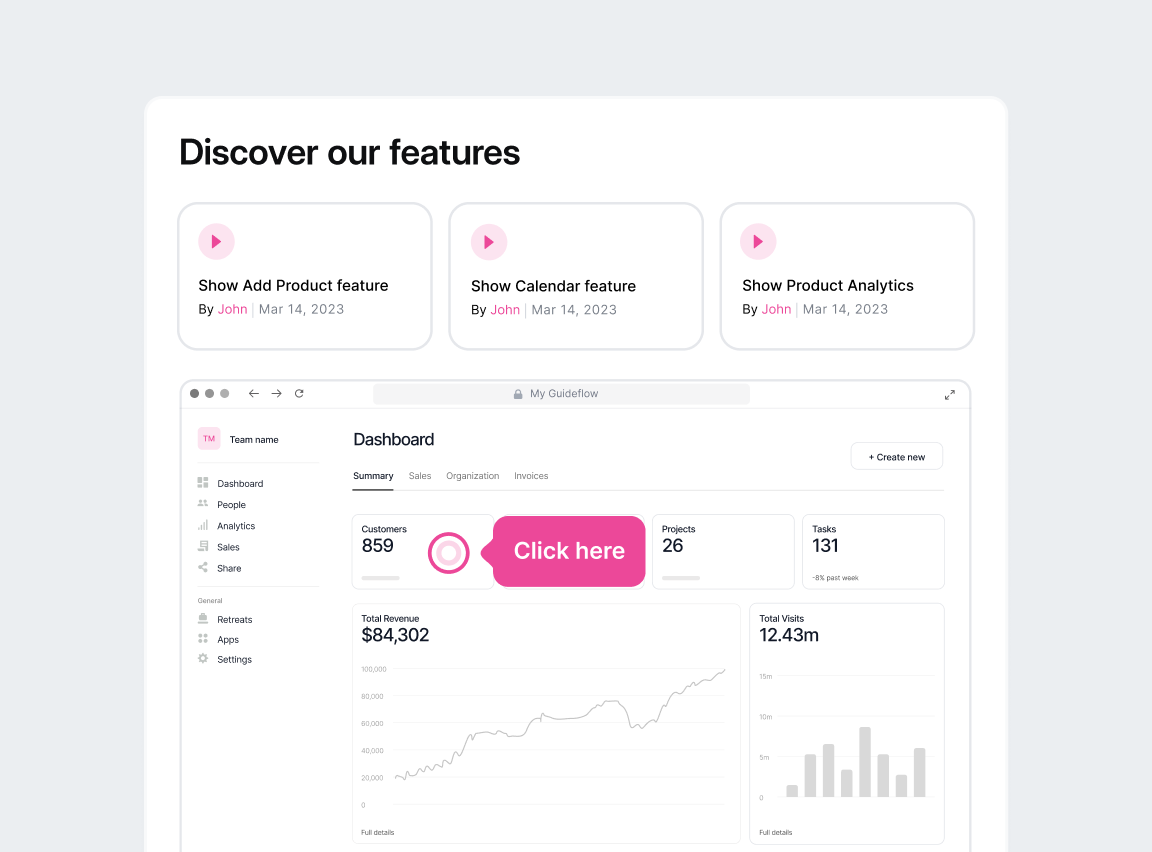
Challenge
Getting new partner reps up to speed presents significant challenges for partnership managers. Traditional onboarding approaches rely on static slide presentations, one-time webinars, or scheduled live walkthroughs that require coordination across time zones and partner tiers. The dependency on synchronous training creates bottlenecks that slow activation and limit scalability.
Partnership managers find themselves repeating the same product demonstrations dozens of times, while partner reps often fail to retain critical information from single-session training. The result is inconsistent product knowledge, delayed time-to-first-deal, and partner sellers who lack confidence when presenting the solution in co-sell scenarios. Without hands-on experience, partners struggle to articulate value propositions, answer technical questions, or effectively position integrations during customer conversations.
Solution
Interactive demos transform partner onboarding from a resource-intensive process into a scalable enablement system. By embedding guided product walkthroughs into your partner portal or learning management system, you create an always-available training resource that works across geographies and schedules. Partner reps gain hands-on exposure to real workflows, exploring features and use cases through self-paced experiences that mirror actual customer scenarios.
Unlike passive video training or documentation, interactive demos allow partners to click through the interface, understand navigation patterns, and experience the product's value firsthand. This approach eliminates the need for partnership managers to conduct repetitive training sessions while ensuring every partner receives the same high-quality, comprehensive product education. Partners can revisit specific workflows as needed, reinforcing learning and building muscle memory that translates directly into confident sales conversations.
Benefits
- Dramatically reduces time-to-readiness by allowing partners to complete training at their optimal pace rather than waiting for scheduled sessions
- Standardizes product messaging across all partner tiers, ensuring consistent positioning whether partners are in North America, EMEA, or APAC
- Improves knowledge retention through active learning experiences that engage partners far more effectively than static materials
- Enables asynchronous enablement that accommodates different time zones, learning styles, and availability constraints
- Scales onboarding capacity without requiring additional headcount on the partnership team
- Provides analytics on partner engagement, revealing which features partners explore most and where they need additional support
- Reduces dependency on solution engineers and product teams for partner training requests
- Creates a foundation for partner certification programs with measurable completion and competency metrics
How to use
- Embed interactive demos directly into your partner relationship management (PRM) platform as required onboarding modules
- Include demo links in automated welcome sequences for newly signed partners, creating immediate value and engagement
- Integrate demos into partner certification programs, requiring completion before partners gain access to co-sell opportunities or MDF
- Create tiered learning paths where basic demos unlock access to advanced product walkthroughs covering enterprise features or complex integrations
- Share demos during quarterly business reviews to refresh partner knowledge on new features or updated positioning
- Use demos as pre-work before live enablement sessions, allowing you to focus synchronous time on advanced topics and Q&A rather than basic product overviews
- Provide demos as resources partners can share with their own internal teams, extending enablement beyond the core partnership contact
Think of interactive demos as the onboarding session that scales infinitely. Every partner rep can access comprehensive product training whenever they need it, whether that's during their first week, before an important customer meeting, or when preparing for a product launch. Partnership managers shift from delivering the same training repeatedly to curating high-impact learning experiences that activate partners faster and more effectively than traditional methods ever could.
Use case 2: Enable co-sell teams with demo assets

Challenge
Co-sell partnerships promise accelerated pipeline and expanded market reach, but the reality often falls short of expectations. Partner sales representatives, even those genuinely excited about the partnership, frequently struggle to effectively communicate product value during customer conversations. Without direct access to your product or deep technical knowledge, they resort to high-level feature lists and generic value propositions that fail to resonate with prospects. This creates a problematic dynamic where every promising opportunity requires scheduling a live demo with your solution engineers, creating bottlenecks that slow deal velocity and limit the number of partner-sourced opportunities your team can support.
Partnership managers find themselves caught between wanting partners to drive independent sales motion and needing to protect limited internal resources. Meanwhile, partner reps lose confidence in their ability to advance deals, defaulting to surface-level conversations that position them as referral sources rather than trusted advisors. The absence of effective enablement tools transforms what should be a scalable go-to-market channel into a resource-intensive extension of direct sales.
Solution
Interactive demos change the economics and scalability of co-sell partnerships by putting demonstration capability directly into partner hands. Rather than relying on scheduled calls with your team or attempting to describe features verbally, partner reps can share guided product experiences that prospects explore independently or during joint conversations.
They showcase actual workflows, highlight integration points that matter to specific industries or use cases, and answer common technical questions through interactive walkthroughs. Partner sellers gain the ability to demonstrate product value at the exact moment prospects express interest, whether during initial discovery, follow-up conversations, or proposal presentations. Interactive demos maintain your intended messaging and positioning while adapting to different selling scenarios, from quick capability overviews to deep dives into specific features. This elevates partner reps from coordinators scheduling demos to consultative sellers who control the narrative and guide prospects through personalized product experiences. Partnership teams shift their focus from delivering repetitive demonstrations to strategic deal support, engaging only when partner sellers need specialized expertise or executive involvement rather than for every product conversation.
Benefits
- Increases partner-sourced win rates by enabling reps to demonstrate value during critical buying moments rather than waiting for scheduled demonstrations
- Reduces solution engineer involvement in partner deals by 60-80%, freeing capacity for complex enterprise opportunities and strategic accounts
- Accelerates sales cycles by eliminating coordination delays between partner discovery calls and product demonstrations
- Ensures consistent product positioning across hundreds of partner sellers, regardless of geography, tenure, or technical background
- Empowers partners to lead with product differentiation rather than generic slide presentations that fail to create urgency
- Enables true scalability where partnership teams can support expanding ecosystems without proportional increases in technical headcount
- Improves deal qualification by allowing prospects to self-educate through demos before requesting live sessions, ensuring better meeting quality
- Builds partner confidence and autonomy, transforming how reps perceive their role in the sales process and their ability to close independently
- Creates measurable engagement data showing which features and use cases resonate most with partner-sourced prospects, informing joint go-to-market strategy
How to use
- Integrate demos into co-sell playbooks as standard assets for specific industry verticals, company sizes, or use cases
- Embed demo links in partner battlecards alongside competitive positioning, ensuring reps have proof points that back up messaging claims
- Load demos into partner relationship management portals and deal registration systems where they become accessible whenever opportunities progress
- Include demos in follow-up sequences after joint discovery calls, allowing prospects to revisit key capabilities and share internally with stakeholders
- Provide demos as alternatives to live product walkthroughs for mid-funnel opportunities where prospects need deeper understanding but full SE involvement cannot scale
- Equip partner account executives with demo collections covering different personas, from end users exploring workflows to technical buyers evaluating architecture and security
- Use demos during partner quarterly business reviews to refresh product knowledge and introduce newly launched features that expand selling opportunities
- Create custom demo versions highlighting specific integration capabilities when partners focus on joint solution selling with complementary platforms
Interactive demos function as virtual product experts accompanying every partner rep into customer conversations. When prospects ask how specific workflows operate, partners share relevant demos immediately rather than promising follow-up or scrambling to schedule internal resources. When technical questions arise about integrations, security, or scalability, partners guide prospects through interactive experiences that address concerns with actual product context rather than static documentation. This capability transforms partnership dynamics from dependency relationships into true extensions of your go-to-market motion, where partners operate with the autonomy and effectiveness that makes co-sell partnerships genuinely scalable and profitable for both sides.
Use case 3: Promote integrations with clickable demos
Challenge
Partnership-driven integrations represent significant engineering investment and strategic alignment between companies, yet they frequently fail to achieve meaningful adoption rates. The root cause typically lies not in the integration's technical capabilities or business value, but in the fundamental challenge of communicating how two systems work together to solve real problems. Documentation approaches that dominate most integration launches rely on API references, configuration guides, and text-heavy explanations that assume technical expertise and fail to convey the tangible outcomes users care about.
Marketing teams struggle to demonstrate integration value beyond generic "now integrated with" announcements that generate initial buzz but provide no pathway to actual implementation. Sales teams, both internal and partner-facing, lack the tools to effectively articulate why the integration matters during customer conversations, defaulting to vague promises about "seamless connectivity" that prospects have heard dozens of times before. Meanwhile, the target users who would benefit most from the integration never develop a clear mental model of how their workflows improve, what data becomes accessible, or which pain points the integration actually addresses. This visualization gap creates a vicious cycle where low initial adoption leads to deprioritization, reducing the strategic value of the partnership and undermining the joint go-to-market motion that justified the integration investment.
Solution
Interactive demos transform integration marketing from abstract concept communication to concrete workflow demonstration. Rather than asking prospects to imagine how two platforms connect or wade through technical documentation to understand data flows, you show them the actual experience through guided walkthroughs that require no system access or configuration. These demos illustrate specific scenarios where the integration creates value, walking through the exact steps a user would take and the outcomes they would achieve. For instance, instead of explaining that your project management tool integrates with Salesforce, you demonstrate how opportunity data automatically populates project timelines, how status updates sync bidirectionally, and how reporting combines information from both systems to provide unified visibility.
The interactive format allows viewers to progress through workflows at their own pace, revisiting specific integration points that matter most to their use cases. This approach bridges the comprehension gap that prevents integration adoption, making technical functionality accessible to business users while providing enough detail to satisfy technical evaluators. Partnership teams gain a scalable asset that works across multiple channels, from marketplace listings and co-marketing campaigns to sales enablement and customer onboarding, ensuring consistent and compelling integration storytelling regardless of who encounters it or where.
Benefits
- Transforms abstract integration capabilities into concrete, visualized workflows that prospects can immediately understand and evaluate
- Accelerates adoption by eliminating the learning curve and uncertainty that typically prevents users from implementing new integrations
- Reduces support burden by proactively answering configuration questions and demonstrating setup processes before users attempt implementation
- Enables non-technical stakeholders to champion integrations internally by giving them clear narratives about how workflows improve and problems get solved
- Strengthens co-marketing initiatives by providing partners with high-impact assets that generate engagement far beyond static announcement posts
- Improves conversion rates on marketplace listings by moving beyond feature claims to actual product experiences that build confidence
- Creates differentiation in crowded integration ecosystems where competitors offer similar connectivity but cannot communicate value effectively
- Generates engagement data showing which integration workflows resonate most, informing product roadmap priorities and partnership strategy
- Scales integration education across global partner networks without requiring repeated webinars or live demonstrations
- Reduces time-to-value for customers by establishing clear expectations and understanding before they begin implementation
How to use
- Feature interactive integration demos prominently on marketplace profile pages where prospects evaluate connectivity options and compare alternatives
- Embed demos in launch announcement emails and blog posts, transforming one-dimensional announcements into engaging experiences that drive immediate exploration
- Include integration walkthroughs in joint webinars with partners, allowing you to demonstrate rather than describe functionality during live presentations
- Provide demos to partner marketing teams as co-branded assets they can share with their audiences, extending reach while maintaining consistent messaging
- Incorporate demos into mutual customer onboarding sequences, showing new users how to leverage integrations as part of their initial setup rather than treating connectivity as an advanced feature
- Use demos during analyst briefings and partnership reviews to communicate integration sophistication and differentiation more effectively than architectural diagrams
- Share demos with partner sales and customer success teams during enablement sessions, giving them confidence to discuss integration value during customer conversations
- Add demos to your integration documentation as visual companions to technical setup guides, helping users understand what they're building toward before diving into configuration details
- Deploy demos in re-engagement campaigns targeting customers who have access to integrations but have not yet activated them, reigniting interest with clear value demonstration
Think of interactive integration demos as your always-available integration specialist who can showcase exactly how systems connect, what workflows improve, and why users should invest time in setup. When partnership managers negotiate new integrations, they secure not just technical connectivity but a complete go-to-market asset that drives awareness, comprehension, and adoption. When partners evaluate whether to prioritize your integration in their own marketing, they see a professional, engaging resource that makes joint promotion worthwhile. When prospects land on marketplace listings or integration pages, they encounter experiences that answer their questions and build confidence rather than leaving them to imagine possibilities. This shifts integration success from depending on documentation quality or support availability to providing self-service clarity that converts interest into active usage, transforming integrations from technical achievements into genuine growth drivers for both partners.
Use case 4: Enrich co-marketing with demos that convert

Challenge
Co-marketing campaigns between strategic partners routinely generate impressive top-of-funnel metrics: thousands of landing page visits, hundreds of content downloads, and respectable webinar attendance. Yet these initiatives consistently fail to translate awareness into qualified pipeline, leaving partnership teams struggling to justify continued investment in joint marketing activities. The fundamental problem lies in the nature of traditional co-marketing assets, which rely on static formats that describe value propositions without demonstrating actual product experiences.
Partnership managers coordinate elaborate content strategies involving eBooks explaining integration benefits, case studies detailing successful implementations, and webinars presenting slide decks about joint solutions. Prospects consume this content but never develop concrete understanding of how the products work together or what their own experience would look like. The gap between marketing claims and product reality creates hesitation that stalls progression from interest to evaluation. Sales teams on both sides receive leads from co-marketing campaigns but find prospects asking basic questions that should have been answered by the content, revealing surface-level engagement rather than genuine comprehension. Meanwhile, the absence of meaningful product interaction makes lead scoring nearly impossible, as content downloads and form submissions provide no insight into whether prospects understand the solution, see relevance to their challenges, or possess any intent beyond curiosity. Partnership teams face pressure to demonstrate return on co-marketing investment but lack the conversion mechanisms that transform attention into qualified opportunities, resulting in initiatives that build brand association without driving revenue outcomes.
Solution
Interactive demos change co-marketing economics by embedding actual product experiences directly into campaign assets. Rather than asking prospects to imagine how solutions work together or wait for sales conversations to see functionality, you provide immediate access to guided walkthroughs that demonstrate real workflows, integrations, and outcomes. They become the centerpiece of joint campaigns, transforming passive content consumption into active product exploration that generates both engagement and qualification signals. When partners promote a joint webinar, attendees do not merely watch presentations but interact with live product experiences that show exactly how the integration operates. When co-branded landing pages describe partnership value, visitors click through to demos that prove claims with tangible functionality rather than requiring faith in marketing copy.
The interactive format allows prospects to explore at their own pace, focusing on the specific workflows and use cases most relevant to their situations while generating behavioral data that reveals genuine interest and understanding. Partnership marketing shifts from awareness-focused broadcasting to conversion-focused experiences where prospects self-educate, self-qualify, and develop the confidence needed to request sales engagement. Both organizations gain visibility into which features and integration points resonate most with joint audiences, informing not just marketing strategy but product roadmap priorities and partnership investment decisions. The demos scale infinitely across channels and geographies, enabling partnership teams to run sophisticated global campaigns without proportionally increasing headcount or coordination overhead.
Benefits
- Transforms co-marketing campaigns from lead generation exercises into pipeline conversion engines by giving prospects product experiences that build genuine buying intent
- Increases marketing-qualified-lead to sales-qualified-lead conversion rates by ensuring prospects arrive at sales conversations with concrete understanding rather than abstract curiosity
- Provides behavioral engagement data that enables sophisticated lead scoring based on which features prospects explored, how long they engaged, and whether they returned for multiple sessions
- Reduces sales cycle length by front-loading product education that traditionally happens during discovery calls, allowing sales conversations to focus on business fit and customization
- Empowers non-technical stakeholders who discover joint solutions through marketing campaigns to champion initiatives internally by giving them clear narratives and visual references
- Differentiates co-marketing efforts in crowded markets where competitors distribute similar content formats but cannot provide interactive product experiences
- Enables attribution analysis showing which partnership campaigns generate not just leads but engaged prospects who progress through sales stages
- Scales campaign impact without linear cost increases, as demos serve unlimited prospects simultaneously across all partner marketing channels
- Strengthens partner relationships by providing marketing teams with high-performing assets that improve their own conversion metrics and campaign results
- Creates reusable campaign components that work across multiple initiatives, from product launches and integration announcements to industry-specific vertical plays
How to use
- Embed demos directly into co-branded landing pages as the primary call-to-action, replacing or supplementing traditional form-gated content with interactive experiences
- Include demo links in joint email campaigns and nurture sequences, allowing recipients to explore products immediately rather than waiting for scheduled demonstrations
- Feature demos during co-hosted webinars and virtual events, transitioning from slide presentations to live interactive sessions where attendees experience actual product functionality
- Distribute demos through partner social media channels and sponsored content campaigns, providing click-through destinations that engage rather than just inform
- Use demos as gated content upgrades where initial form submissions unlock basic resources while demo access requires additional qualification, creating tiered engagement paths
- Incorporate demos into partner newsletter placements and content syndication programs, ensuring your solution can be experienced wherever partner audiences consume information
- Deploy demos in retargeting campaigns for prospects who engaged with initial co-marketing content but did not convert, providing the product experience that moves them forward
- Share demos with partner field marketing teams for use at trade shows and regional events, enabling booth staff to provide instant product experiences without relying on live environment access
- Add demos to marketplace listings and app directories as companion assets to co-marketing announcements, capturing interest generated by promotional activities with immediate product access
Interactive demos function as the conversion layer that co-marketing campaigns have historically lacked. When partnership teams plan joint initiatives, they secure not just content distribution but genuine product engagement that moves prospects through buying stages. When partners evaluate whether to invest marketing resources in joint campaigns, they see assets that drive their own success metrics rather than just supporting partner objectives. When prospects encounter co-marketing materials, they experience solutions rather than reading about them, developing the conviction that justifies taking next steps. This transforms partnership marketing from a volume game focused on reach and impressions into a precision instrument that generates qualified pipeline, proving partnership value through revenue contribution rather than activity metrics.
Use case 5: Deliver partner training and certification with confidence
Challenge
Partnership teams invest heavily in enablement programs designed to transform partner sales representatives into credible advocates who can articulate value propositions, demonstrate functionality, and close deals. Despite this investment, most partner training fails to produce lasting competency. Traditional approaches rely on static materials like PDF product guides, slide decks outlining feature sets, and lengthy webinars where presenters walk through screenshots while partners passively observe. These formats create superficial familiarity rather than genuine understanding, leaving partner representatives unable to confidently discuss products weeks after completing certification. The fundamental issue is that passive consumption does not build the muscle memory and contextual knowledge required for effective selling. Partners attend training sessions, pass basic quizzes testing recall of talking points, receive certification badges, and then struggle when facing actual prospect questions because they never experienced the product in realistic scenarios.
This knowledge gap becomes particularly acute as partner networks scale globally, with representatives across different regions, languages, and time zones all requiring consistent enablement without the partnership team's ability to deliver personalized live training to each individual. Meanwhile, products evolve continuously, with new features, integrations, and use cases emerging faster than partnership teams can schedule refresh training sessions. Partners certified months ago operate with outdated understanding, unaware of capabilities that could win deals or address customer challenges. The result is a persistent gap between partnership potential and actual performance, where channel partners generate disappointing results not from lack of effort but from inadequate product knowledge that prevents them from competing effectively against direct sales teams or partners representing competing solutions.
Solution
Interactive demos transform partner enablement from passive information transfer to active skill building through experiential learning. Rather than asking partners to memorize feature lists or watch someone else navigate products, you provide hands-on environments where they explore realistic workflows, encounter common scenarios, and develop intuitive understanding of how products solve problems. These guided experiences replicate the discovery process prospects go through, allowing partners to internalize not just what products do but why capabilities matter and how to articulate value in customer conversations. Partners progress through structured learning paths at their own pace, spending time on areas where they need reinforcement while moving quickly through familiar concepts.
The interactive format accommodates different learning styles and experience levels, providing consistent outcomes across diverse partner populations without requiring the partnership team to scale live training proportionally with network growth. Because demos exist as digital assets accessible on demand, partners revisit them when preparing for specific deals, refreshing knowledge about particular features or use cases relevant to immediate opportunities. This just-in-time learning ensures competency remains current and contextually relevant rather than fading after initial certification. Partnership teams update demo content centrally as products evolve, ensuring every partner accesses current information without requiring recertification programs or notification campaigns about what changed. The behavioral data generated by demo engagement provides partnership managers with visibility into where partners struggle, which features they explore most, and who demonstrates genuine product mastery versus superficial completion of training requirements. This intelligence informs both individual coaching priorities and systemic improvements to enablement curriculum, creating continuous refinement based on actual learning patterns rather than assumptions about what partners need to know.
Benefits
- Builds genuine product competency through hands-on exploration rather than passive observation, increasing partner confidence during customer conversations
- Scales enablement across global partner networks without linear increases in partnership team resources or coordination of time zone scheduling
- Accommodates different learning paces and styles, allowing experienced partners to move quickly while newer partners take additional time on foundational concepts
- Maintains knowledge currency as products evolve, with centralized updates automatically reflected across all partner training experiences
- Reduces time to competency for new partners by providing immediate access to comprehensive product experiences rather than waiting for scheduled training cohorts
- Enables just-in-time learning where partners refresh specific knowledge areas when preparing for relevant deals rather than trying to retain everything from initial training
- Provides partnership teams with engagement analytics revealing which partners demonstrate mastery versus surface-level completion, informing coaching investments
- Supports multilingual partner networks through demos that transcend language barriers by showing rather than explaining functionality
- Increases partner deal win rates by ensuring representatives can demonstrate and discuss products with the same fluency as direct sales teams
- Creates reusable training components that work across onboarding, certification, ongoing education, and deal preparation scenarios
How to use
- Embed interactive demos directly into partner certification programs and learning management systems as core curriculum components rather than supplementary materials
- Structure onboarding tracks for new partners around progressive demo experiences that build from basic concepts to advanced functionality
- Provide demos as pre-work before live enablement sessions, allowing facilitated time to focus on advanced topics and questions rather than basic product orientation
- Share demos as refresher resources for existing partners, particularly when preparing for important deals or re-engaging after periods of inactivity
- Use demos during quarterly business reviews with strategic partners to identify knowledge gaps and establish focused development plans
- Deploy demos as self-service resources partners can access whenever questions arise, reducing dependency on partnership team availability for basic product guidance
- Incorporate demos into partner sales kickoffs and regional training events, providing hands-on breakout sessions that complement keynote presentations
- Distribute demos to partner marketing teams so they can train their own content creators and campaign managers on product functionality without requiring technical expertise
- Track demo engagement as a leading indicator of partner performance, identifying which partners demonstrate deep product exploration versus minimal compliance with training requirements
Think of interactive demos as on-demand coaching that replicates the experience of shadowing expert sales representatives through discovery conversations and product demonstrations. When partnership teams design enablement programs, they create learning experiences that build lasting competency rather than temporary familiarity. When partners complete training, they possess practical skills and contextual understanding that translate directly into effective customer interactions. When prospects engage with partner representatives, they encounter knowledgeable advocates who demonstrate product value with confidence and precision. This shifts partner enablement from a compliance exercise focused on certification completion rates to a capability-building system that drives measurable improvements in partner-sourced revenue, deal sizes, and win rates against competition.
Use case 6: Support live product demonstrations at events and webinars

Challenge
Partnership teams invest substantial resources in events, webinars, and field marketing activities where live product demonstrations serve as centerpiece moments that convert attendee interest into qualified pipeline. These high-stakes presentations carry significant risk because they depend on factors beyond the presenter's control. Unreliable conference WiFi networks can cause applications to freeze mid-demonstration or prevent cloud-based products from loading entirely. Unfamiliar venue environments lack the test data, configured integrations, and customized settings that make demonstrations compelling and relevant to specific audiences. Products that depend on third-party systems or real-time data connections introduce additional failure points where a single unavailable API can derail carefully scripted presentations. Even experienced presenters encounter unexpected behavior when demonstrating in production environments where recent updates changed interface elements or workflows they planned to showcase.
These technical disruptions do more than create awkward pauses during presentations. They undermine credibility with prospects who question whether products genuinely work as advertised, erode partner confidence in their ability to represent solutions effectively, and waste the marketing investment required to assemble audiences in the first place. Many partnership teams respond by avoiding live demonstrations altogether, defaulting to slide presentations with screenshots and recorded video clips that feel dated and disconnected from actual product experiences. This conservative approach eliminates technical risk but also eliminates the engagement and conviction that comes from seeing products respond to inputs and solve problems in real time. Partners presenting without live product access struggle to answer specific questions about workflows or functionality, forcing them to defer to follow-up conversations and losing momentum generated by event attendance. The challenge intensifies as partnership teams scale event programs globally, with local partners hosting regional events where corporate technical resources cannot provide on-site support and where variations in languages, compliance requirements, and market-specific use cases make standardized demonstration environments impractical to maintain.
Solution
Interactive demos provide the engagement and credibility of live product demonstrations without the technical dependencies that create risk during events and webinars. These pre-built experiences replicate actual product interfaces and workflows through clickable environments that respond to user inputs exactly as real applications would, but operate independently of backend systems, internet connectivity, or complex configurations. Partnership teams create demonstration scenarios tailored to specific event audiences, incorporating relevant use cases, industry-specific examples, and integration workflows that resonate with attendees. Presenters navigate these interactive environments during sessions, clicking through realistic workflows while explaining functionality and business value. From the audience perspective, the experience mirrors a live demonstration with visible interfaces responding to actions, but without the latency, crashes, or unexpected behavior that plague actual product environments. Partners can confidently showcase sophisticated functionality including integrations with systems that might be unavailable or difficult to configure for demonstration purposes. The interactive format accommodates various presentation styles, from presenter-led walkthroughs during keynotes to self-guided exploration during booth interactions or breakout sessions where attendees navigate demos on their own devices. Because demos exist as standalone web assets, they work equally well in large conference centers with thousands of attendees, intimate executive roundtables, or virtual webinars reaching global audiences. Partnership teams distribute the same demo assets to field marketing teams across regions, ensuring consistent product storytelling regardless of who presents or where events occur. After presentations conclude, these same demos become valuable follow-up assets that extend event engagement beyond the session itself, allowing attendees to revisit workflows they saw presented or explore additional functionality at their own pace.
Benefits
- Eliminates technical failure risks associated with live product environments, ensuring presentations proceed smoothly regardless of venue conditions or connectivity quality
- Enables partners to confidently demonstrate sophisticated functionality including integrations and advanced workflows without requiring technical expertise or systems access
- Maintains audience engagement through responsive interfaces that provide the interactivity of live demonstrations without the delays and complications of actual products
- Scales demonstration capability across global partner networks and regional events without requiring corporate technical resources to provide on-site support
- Supports both presenter-led sessions and self-guided exploration, accommodating different event formats from keynotes to booth interactions
- Provides consistent product storytelling across all partner presentations, ensuring audiences receive accurate and compelling demonstrations regardless of presenter experience
- Extends event value beyond live sessions by serving as follow-up content attendees can explore after presentations conclude
- Reduces preparation time and technical setup requirements for partners hosting events, allowing them to focus on audience engagement rather than troubleshooting connectivity
- Enables demonstration of features and integrations that would be impractical to configure in live environments due to compliance restrictions, data privacy concerns, or system availability
- Increases partner confidence in event participation by providing reliable assets that consistently deliver successful demonstrations
How to use
- Embed demos into webinar presentations as the primary demonstration method, allowing presenters to navigate realistic product environments while explaining functionality to remote audiences
- Deploy demos on booth tablets and displays at trade shows and conferences, enabling attendees to explore products hands-on while booth staff provide context and answer questions
- Include demo links in event microsites and registration confirmation emails, allowing attendees to preview functionality before sessions or explore in depth afterward
- Share demos during partner-led field events and regional roadshows, providing consistent demonstration experiences across distributed marketing programs
- Use demos in breakout sessions and workshops where participants navigate workflows on their own devices while facilitators guide discussion
- Add demos to post-event follow-up campaigns and nurture sequences, maintaining engagement with attendees through interactive content that reinforces messages from live presentations
- Provide demos to executive briefing center teams and customer success groups who host intimate sessions where polished demonstrations are expected but technical setup is impractical
- Incorporate demos into virtual event platforms and digital experience hubs, creating always-available product exploration zones within broader event environments
Interactive demos function as a reliable presentation layer that preserves the engagement value of live demonstrations while eliminating the technical risks that make event presentations unpredictable. When partnership teams plan events and webinars, they equip partners with demonstration capabilities that work consistently regardless of technical constraints or presenter expertise. When partners present to prospects, they confidently showcase product functionality knowing their demonstrations will proceed as planned. When attendees experience these presentations, they witness realistic product interactions that build conviction without the awkward pauses and apologies that accompany failed live demonstrations. This transforms events from awareness activities into genuine product education moments that move prospects through buying stages, proving partnership value through the quality of experiences delivered rather than just the attendance numbers generated.
Use case 7: Share demos directly in partner communications
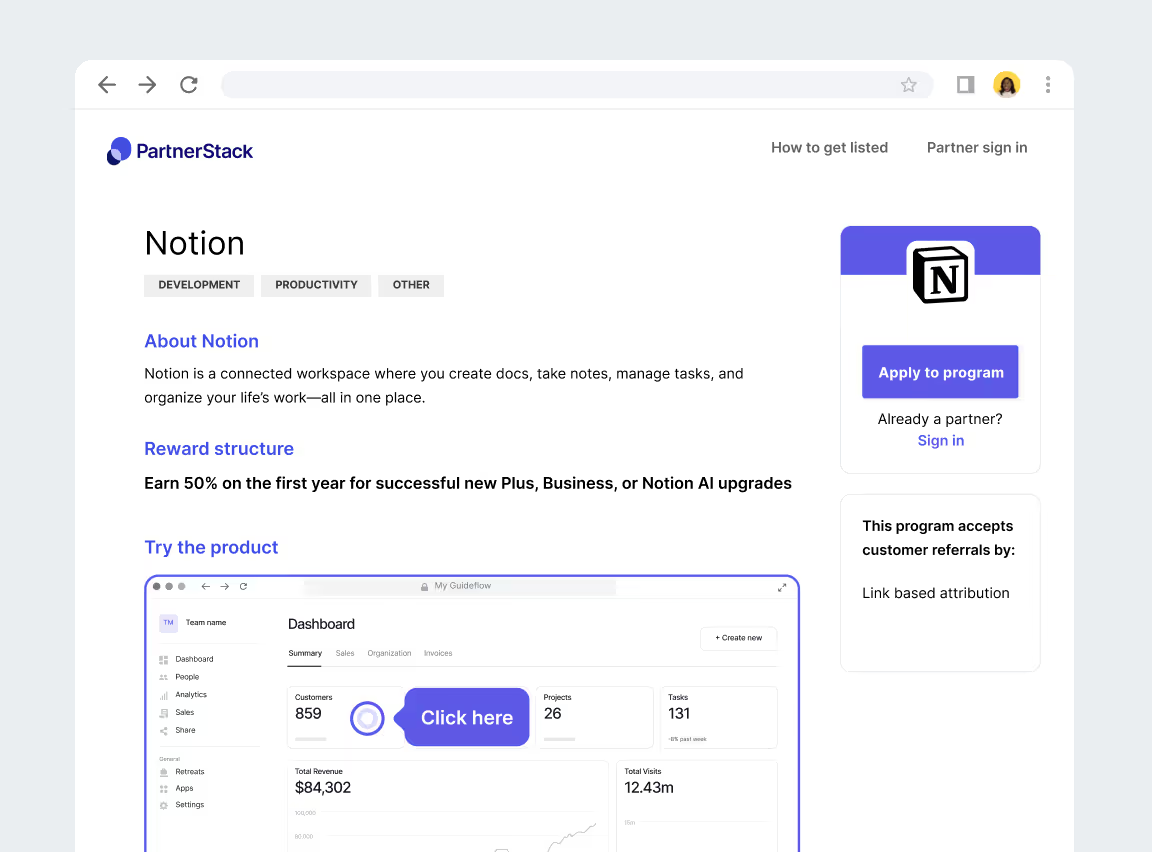
Challenge
Partnership teams maintain ongoing communication cadences with partner networks through monthly newsletters, portal announcements, enablement bulletins, and campaign launch alerts. These communications serve critical functions including announcing product updates that affect customer conversations, sharing new competitive positioning that partners should incorporate into pitches, distributing integration guides for newly supported platforms, and reinforcing messaging frameworks for upcoming campaigns. Despite the strategic importance of this information, most partner communications achieve minimal engagement.
Partners receive dozens of emails weekly from multiple vendor relationships, all competing for attention alongside their internal priorities and direct customer demands. Static content formats like PDF attachments, text summaries, and links to documentation portals require substantial cognitive effort to process and apply. A partner who receives a bulletin about new API capabilities must read technical descriptions, imagine how those capabilities solve customer problems, and mentally translate features into selling points they can use during conversations. This abstraction creates friction that prevents learning from occurring at the moment information arrives. Partners often intend to review materials later when they have dedicated time, but that moment rarely comes. Important updates get buried in inboxes or lost among dozens of unread portal notifications. Even partners who engage with communications struggle to retain information presented through text and screenshots alone. Reading about a new workflow differs fundamentally from experiencing how that workflow operates within actual product interfaces. When partners encounter relevant selling situations weeks after receiving communications, they retain vague awareness that certain capabilities exist but lack the detailed understanding needed to discuss them confidently with prospects. This gap forces them to defer to follow-up conversations, request support from partnership managers, or simply avoid mentioning functionality they cannot explain clearly. The challenge intensifies as product velocity increases and partnership teams need to keep distributed networks aligned with rapid releases, shifting competitive landscapes, and evolving go-to-market strategies. Traditional communication approaches that rely on partners reading and internalizing written materials cannot match the pace of change or overcome the attention constraints partners face.
Solution
Interactive demos embedded directly within partner communications transform passive information distribution into active learning experiences that drive immediate comprehension and retention. Rather than describing new product capabilities or workflow changes through text and screenshots, partnership teams embed clickable demo environments directly in emails, Slack channels, partner portal feeds, and PRM system updates. Partners engage with actual product interfaces within the communication context itself, clicking through workflows, seeing how features respond to inputs, and experiencing functionality rather than reading about it. A newsletter announcing enhanced reporting capabilities includes an embedded demo where partners immediately explore the new dashboard, filter data, and generate reports through hands-on interaction.
An integration guide distributed via Slack contains a walkthrough demo showing exactly how the connection operates, what data syncs between systems, and how end users experience the integration. Campaign launch communications include demos of the specific product workflows that sales teams should emphasize during the promotional period, ensuring partners can discuss those capabilities with the same fluency expected during the campaign. This embedded approach eliminates the friction that prevents engagement with traditional resources. Partners do not need to download attachments, navigate to external portals, or context-switch to separate learning environments. The learning happens at the exact moment they receive information, when context is clearest and motivation is highest. Demos provide self-paced exploration that accommodates different learning speeds and depths of interest, allowing some partners to quickly confirm their understanding of changes while others spend additional time mastering details. Because demos live as web assets, they remain accessible beyond the initial communication, serving as on-demand references partners can revisit when preparing for specific deals or refreshing their knowledge before customer conversations. Partnership teams gain visibility into which communications drive genuine engagement versus which get ignored, tracking demo interactions to understand what content resonates and which partners actively invest in staying current. This intelligence informs communication strategy, highlighting topics that warrant deeper enablement investment and identifying partners who may need additional support to maintain product competency.
Benefits
- Increases partner engagement with critical communications by replacing passive reading with active product exploration that captures attention
- Drives immediate comprehension of new features, updates, and positioning by allowing partners to experience functionality rather than interpret descriptions
- Improves knowledge retention by creating hands-on learning moments that embed understanding more deeply than text-based explanations
- Reduces time partners spend processing updates, as interactive experiences convey complex information more efficiently than written documentation
- Eliminates friction between receiving information and applying it, as partners build working knowledge at the moment they learn about changes
- Provides just-in-time enablement that allows partners to refresh specific knowledge areas by revisiting embedded demos when relevant opportunities arise
- Scales communication effectiveness across global partner networks without requiring live sessions, recordings, or time zone coordination
- Enables partnership teams to identify which partners actively engage with updates versus those who remain disconnected from current product knowledge
- Supports multilingual partner networks through demonstrations that transcend language barriers by showing rather than describing functionality
- Increases partner confidence during customer conversations by ensuring they possess current, detailed understanding of capabilities they represent
- Creates reusable learning assets that serve ongoing reference functions beyond the initial communication distribution
How to use
- Embed demos in monthly partner newsletters to showcase new product releases, competitive differentiators, or integration capabilities announced in that period
- Include demos in campaign launch communications to ensure partners can confidently discuss the specific features and use cases emphasized during promotional periods
- Add demos to portal announcements and PRM system updates as the primary way to communicate workflow changes or interface updates that affect partner activities
- Share demos via Slack channels and messaging platforms where partners receive quick updates, providing immediate hands-on context for brief announcements
- Distribute demos in post-webinar follow-up emails, allowing partners to explore topics covered during live sessions at their own pace and convenience
- Send demos as refreshers before major events, campaign launches, or planning sessions where partners need current product knowledge to participate effectively
- Include demos in quarterly business review materials shared with strategic partners, providing interactive references they can explore while discussing joint planning priorities
- Incorporate demos into onboarding sequences for newly recruited partners, ensuring early communications build product familiarity through exploration rather than passive reading
- Use demo engagement metrics to identify which partners actively invest in staying current, informing coaching priorities and support resource allocation
Think of embedded demos as transforming every partner communication from a broadcast announcement into a capability-building moment. When partnership teams send updates, they create opportunities for partners to immediately develop the competencies those updates require. When partners receive communications, they encounter learning experiences designed for their attention constraints and learning preferences rather than content formats optimized for ease of creation. When prospects engage with partner representatives, they interact with knowledgeable advocates who remain current with product evolution because staying informed requires minimal friction and maximum relevance. This shifts partner communications from an information distribution function that struggles with engagement to a continuous enablement system that builds and maintains the product fluency partnerships depend on to drive revenue outcomes.
How to create interactive demos with Guideflow
Creating high-impact interactive demos for partner enablement is more than product walkthroughs; it empowers partner teams to learn, pitch, and co-sell confidently. Whether you're onboarding reps, showcasing integrations, or launching joint GTM plays, here's how to build demos that scale your partnership impact.
1. Start with a partnership goal
What’s the job of this demo? Are you enabling a new partner cohort, explaining an integration workflow, or supporting a co-marketing campaign? Define the business purpose so your demo is focused, relevant, and measurable.
Tip: Link your demo to a partner KPI like onboarding completion, joint pipeline created, or certification pass rate.
2. Map the partner context
Your audience isn’t a general user; it’s a partner team that needs clarity, not complexity. Tailor your flow around what they need to understand to sell or support your product. Include only the most relevant workflows, pain points, and positioning. Think like a partner manager: What does this partner need to confidently speak to our solution? What should they retain after 90 seconds?
3. Storyboard the enablement journey
Before building, outline the journey. Where should the partner start? What’s the key “aha” you want them to reach? Keep the flow tight, ideally under 5 steps, and build toward a clear CTA, such as “share this with your team” or “start pitching now.”
This step helps align with internal stakeholders (sales, product, enablement) before production begins.
4. Record and guide the experience
Use Guideflow to capture a real product flow or integration. Then overlay clear, friendly guidance scripts, modals, or highlights that speak in your partner's voice. Reinforce how your product fits into joint solutions and why it matters for their customer base.
Use phrasing like “Here’s how to position this to your customer…” or “This solves X for our joint users.”

5. Add personalization for partner impact
Guideflow supports dynamic tokens and branching, so you can tailor demos to different partners, regions, or solution types. Include their logo, use case, or value props to make it feel co-branded, even if the backend is standardized.
Bonus: Create forked flows for different roles (AE vs. CSM) or verticals (healthcare vs. fintech).

6. Embed, share, and enable
Put your demo where partners already operate partner portals, onboarding hubs, newsletters, Slack, or outbound enablement decks. Use Guideflow’s analytics to monitor completion rates, drop-offs, and shares, so you can iterate and scale what works. Track partner demo engagement alongside other enablement KPIs to spot gaps and opportunities. Think of Guideflow as your virtual partner trainer working 24/7 to enable every rep, everywhere, with the same story, the same quality, and none of the scheduling stress.
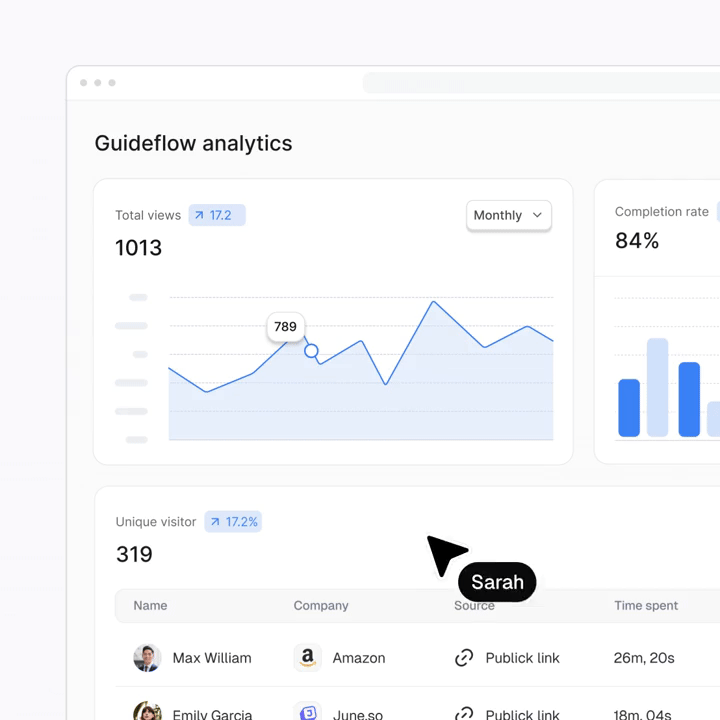
Conclusion
In today’s ecosystem-driven world, partnership success hinges on clarity, scale, and consistency. Interactive demos are no longer a “nice to have,” they’re a core asset for every stage of partner collaboration. From onboarding and enablement to co-selling and integration launches, these demos bridge the gap between knowledge and action, helping partners confidently understand, position, and promote your solution.
Instead of repeating the same walkthroughs, chasing inconsistent messaging, or relying on static PDFs, you can deliver immersive, branded, and trackable product experiences available anytime, anywhere, for every partner. Interactive demos empower your team to scale without sacrificing quality. They unlock faster time-to-readiness, deeper product understanding, and stronger engagement across your entire partner ecosystem.
→ With Guideflow, you can turn every partner into a confident solution seller.
Related posts
Learn more about Guideflow, our approach to authentication, and company news.





